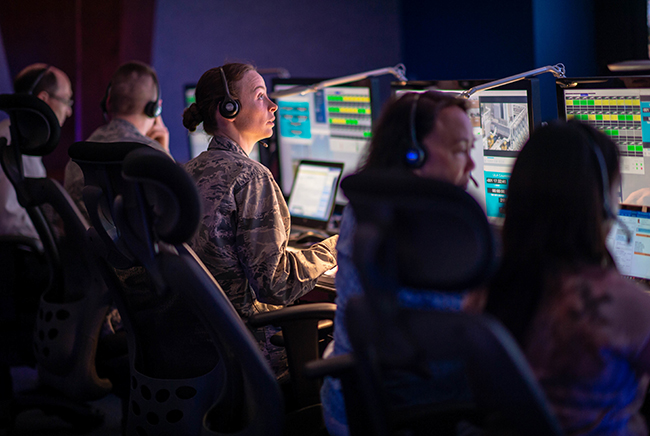
Capt. Elizabeth Forbes, lead, AEHF-5 Launch Operations, of the Space and Missile Systems Center, runs through the countdown checklist while on console inside the historic Hanger AE Launch Control Center at Cape Canaveral AFS, Fla., on Aug 8, 2019. SMC photo by Van Ha.
The Air Force Space and Missile Systems Center is reaching out to industry to answer some of the biggest questions of the new military space era for its study on how the service buys its space launch assets and puts systems on orbit.
“Where do you see future space revenue markets” the Air Force asked in an Oct. 25 request for information. “Since space has been added as an operational warfighting domain, does assured access to space need to be re-evaluated from a national security standpoint”
The answers will inform how the Air Force approaches the third phase of its National Security Space Launch program to launch small, medium, intermediate, and heavy payloads.
The National Security Launch Architecture study began in early October to focus on 2025 and beyond. It affects later parts of NSSL, which was recently revamped to consider reusable rockets, more flexible launches, and new cost-cutting ideas. The Air Force is vetting companies for the program’s second phase.
SMC seeks “innovative developments in launch, on-orbit maneuverability, and commodity transport architectures for on-orbit servicing,” or ways to ensure assets can be worked on in space, according to an Oct. 25 release.
“Historically, [national security space] launch systems and services were procured in a benign space operating environment. This environment allowed for the acquisition of long-life, highly capable, and expensive space systems that required high reliability and the motivation to strive for near 100 percent mission success,” the RFI said. “Looking forward, all components of space weapon systems, including NSS satellites, ground, and launch elements will be required to successfully support warfighter needs under demanding hostile environments.”
To meet that need, the Air Force is eyeing more small satellites in low and medium Earth orbits, and ground control systems that are more cyber secure and work with a range of space assets. The service is assessing its options for how it can get resources to space and maneuver in that domain.
Brian Weeden, a space policy expert for the Secure World Foundation, said it could be hard for the Air Force to tell which commercial technologies will come to fruition in a way that is useful for the Defense Department. Commercial companies may fear bureaucratic delays or outright program cancellation.
“The intent was good but the challenge has always been follow-through. It’s been DOD/[Director of National Intelligence] policy since 2011 to leverage commercial and allied capabilities to improve the resilience of space capabilities,” Weeden said. “Yet it’s hard to point to a single major space acquisition program and see it actually being done.”
USAF will hold an industry day in early December.